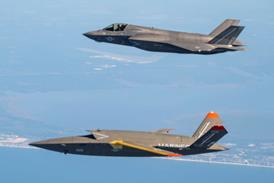Untangling the roots of today's TP400-D6 turboprop is almost as difficult as sourcing the DNA of the airframe. Although originally configured with turboprops in its initial FIMA study configurations, the notion of turbofans emerged strongly in the early FLA/Euroflag days in 1991.
By 1992 the FLA was firmly embracing studies of an "off-the-shelf" turbofan in the 18,000lb (80kN) thrust range, including a version of the BMW Rolls-Royce BR700 designated the RB583-04. By the time of the 1993 Paris air show it emerged that Euroflag was even the target for a proposed multi-national 12,000-20,000lb turbofan concept dubbed Project Blue. The original team included General Electric, Snecma, MTU and Pratt & Whitney, the latter two eventually pushing the project into reality as the much-altered PW6000 turbofan.
Arguing against the cost and tactical unsuitability of turbofans, planners within the FLA project continued to push for turboprops to stay part of the study. By early 1994 the focus was divided between turbofan and turboprop options, though the requirement for the latter was sketched out to be 9,000-12,000shp (6,700-8,900kW), a power range that straddles the engine eventually selected for the A400M.
Many of today's EPI partners were by then also beginning to position themselves for the programme, with BMW Rolls-Royce having teamed with Hispano-Suiza, Ratier-Figeac, ZF Luftfarhttechnik and Dowty Aerospace. At the same time other contenders were emerging, including Allison Engines' AE2100 turboprop and the ZMKB/Progress D-27 propfan in development for the Antonov An-70 - an aircraft that would itself almost kill the FLA before it ever got going.
By the end of April 1994, the turboprop protagonists seized the day with two main groups emerging to compete for the prize. The first, led by BMW Rolls-Royce, continued to offer a version of the BR700, while Snecma, MTU and FiatAvio joined forces to submit an advanced turboprop based on the core of the M88-2 engine developed for the Dassault Rafale fighter. The argument by both was that turboprops would ultimately be cheaper and more rugged than turbofans in the rough field environment. It also appeared that a turboprop was more suitable to performing the very steep tactical approach required for any C-130 replacement.
At the same time, it became obvious that the FLA needed an all-new turboprop to achieve the aircraft's projected high-altitude cruise speed target of Mach 0.72. Only slightly slower than the turbofan-poweredC-17's Mach 0.77, the speed requirement, however, was to pose a stiff challenge for both teams.
Speed was a big enough issue to cause trouble even beyond the apparent "volte face" over the selection of a turboprop, and differing opinions over the ability of the engine to meet the requirement threatened to split the partners. By the end of 1994 the problems still rumbled along, this time with the then-chairman of Snecma, Bernard Dufour, questioning the turboprop decision as "inappropriate". Instead, to the shock of many, Dufour advocated a twin-engined turbofan-powered FLA based on a proposed 43,000lb-thrust version of the CFM56. However, the then-French defence minister Francois Leotard reaffirmed the commitment to the turboprop selection, and Snecma returned to the fray with details of its proposed M88-2 derivative, now called the M138.
From 1995, the engine effort stabilised, with only the entry of AlliedSignal (later Honeywell) with a proposed AS812 turboprop variant of the TFE1042 turbofan, to distract the studies of the two main teams. In February 2000, Snecma, MTU, FiatAvio and ITP of Spain formally established Turboprop International (TIP), to develop the M138 for what had now become the A400M.
Although the team, based in Munich, was fully established and was competing against the BR700-TP then being proposed by BMW Rolls-Royce, the political need for a pan-European solution remained. Responding to political pressure, R-R opened negotiations with the TIP alliance members, but the stumbling block was Snecma's preference for its traditional twin-shaft M88-based core, versus R-R's three-shaft design.
By mid-2000 a compromise was agreed under which R-R wouldformally join TPI with the understanding that the core would remain a heavily modified M88-2 based design, but incorporating three-shaft technology. In September that year, the newly expanded TPI , also including Belgium's Techspace Aero, signed a memorandum of agreement to submit a joint powerplant proposal for the A400M. At the same time, the separate bids from TPI and the original BR700-TP bid by R-R remained valid.
The joint bid was selected by AMC and the revised partnership was formally reformed as the Aero Propulsion Alliance (APA) joint venture the following June in recognition of its new role. MTU, R-R and Snecma each took a 24.8% share, ITP a 13.6% share, FiatAvio 8% and TechSpace Aero 4%. Although all seemed well, disaster was to follow when, within only months, APA admitted that preliminary figures showed the modified M88-based engine would not meet the A400M's weight or specific fuel consumption targets.
The event led to a frantic year in 2002 as AMC re-opened the competition and the APA team hastily went back to the drawing board. In the meantime FiatAvio and Techspace Aero pulled out of APA, the former because of Italy's decision to bale out of the A400M programme. Pratt & Whitney Canada, sensing an opportunity, entered the fray with a 16,000shp-rated turboprop based on its PW800 gas generator called the PW180, while the reconstituted EuroProp International (EPI) presented details of its all-new three-shaft concept. The EPI team included Techspace Aero, now majority owned by Snecma, while Avio would later assume a key role as gearbox supplier.
Delayed by the financial attraction of the P&WC bid, the AMC decision slipped into May 2003. The award, however, finally went to EPI, which had been forced to make serious changes to meet the 20% lower price tag of the PW180. The announcement provoked fury across the Atlantic, where the US Congress and United Technologies accused the European group of making political rather than price-based decisions. Unperturbed, EPI continued its build-up and in November 2003 opened its headquarters near Madrid.
Source: Flight International























